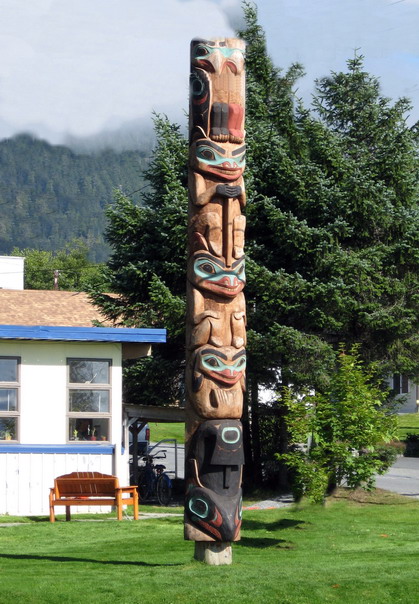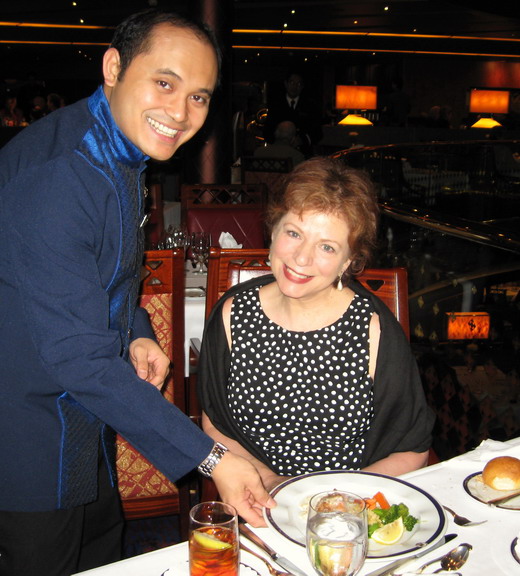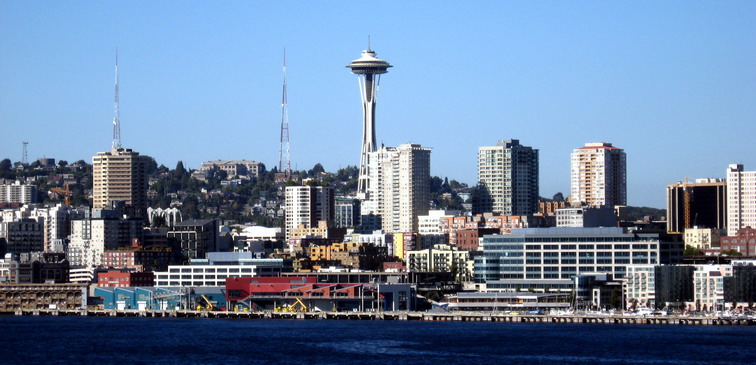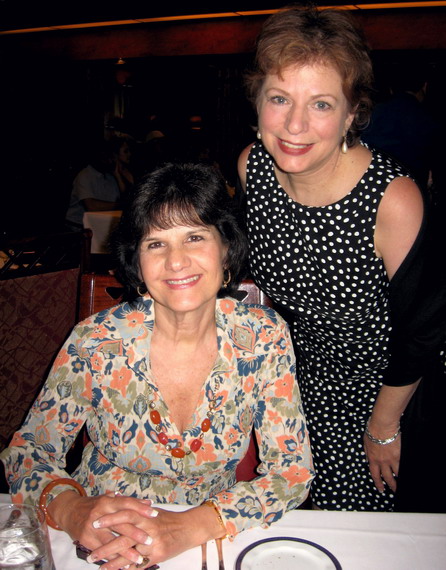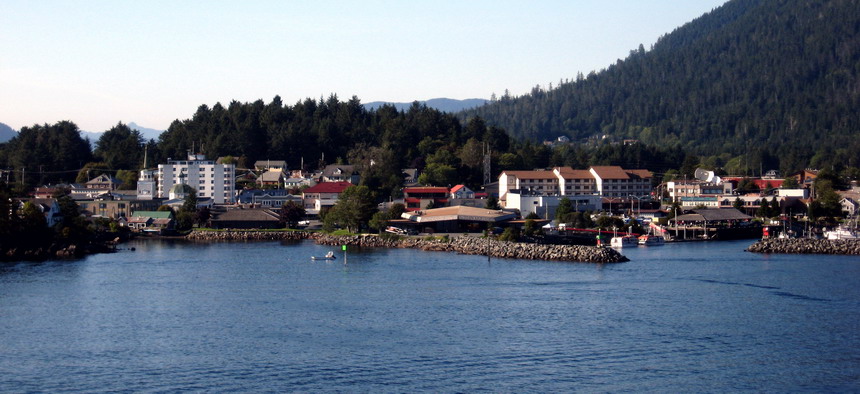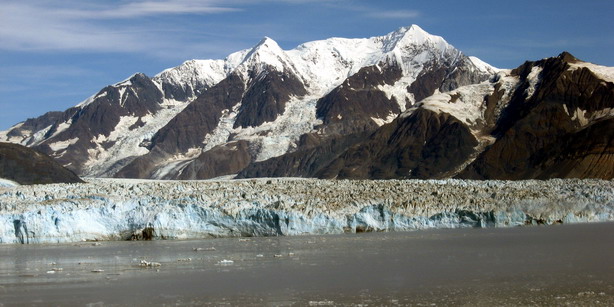Sunday, September 16, 2007
Victoria and Seattle
So we visited the Empress Hotel - a sumptuous old structure in the grand European style. It was filled with English antiques, Spode dishware, mahogany woodworking, Indian tapestries, historic photos of the hotel in the 1930s, and many other elements of refined living. The exterior was old brownstone covered with ivy, and the gardens were lush and well cared for. It was all quite lovely.
As we walked along the small craft harbor, we snapped photos of the hotel reflected in the water and studied the Parliament buildings, which were constructed to honor Queen Victoria's jubilee. Later that night, they were lit up like a big wedding cake, as they have been for 100 years.
As evening fell, we walked up Government Street, poking into one shop or another - looking at handmade soaps, fine bags, cheap t-shirts, luggage, and other goods. Street musicians played to the delight of passing crowds, and everything seemed very safe and clean. Canadians, by and large, were very polite, and the streets were free of graffiti and litter.
By 9pm, we were quite tired from three hours of walking, so we caught the bus back to the ship. The Vista Restaurant had already closed, so we had a quick bite at the buffet. It was our last official meal on the ship, and you could sense the low-key feelings from all the guests. Tomorrow would send us back to reality.
Saturday morning came too quickly, as we finished our last-minute packing and had a quick breakfast of fruit and coffee. We were off the ship by 10am, saying our last good-byes to the stewards and others who had become our temporary friends during the trip.
My college friend Margie Coles picked us up at the terminal and recommended a quick run through Pike Place Market. Talk about mind-boggling! It was a long stretch of stalls packed with all manner of local goods - giant peaches, exotic vegetables, juicy berries, aromatic mushrooms, two-pound lobster tails, whale-sized salmon, spiced teas, handmade sausages, local arts and crafts, organic honeys, huge colorful bouquets, and much more. We pushed our way through the crowds doing their weekend shopping, as well as tourists snapping photos and gawking at the sheer variety of goods.
Along the streets, there were life-size pig sculptures, each designed by an artist and intended for a fundraising auction. Celebrating the market's 100th year, the pigs were done up in Piccaso-style paints, or covered with pennies, or dressed like Carmen Miranda, or wearing baby clothes, or looking like mermaids. It was all very clever.
Taking us up to her home on Queen Anne Hill, Margie gave us a running commentary about the neighborhood history before we met her husband Neal. What a great guy... someone who obviously loves Margie and is quite settled, bright, and funny. He's a real keeper.
After conversation over cheese and crackers, we drove over to see a fantastic view of the city from one of the local parks. A couple of bridal families were there for photos - a Seattle tradition, with the Space Needle and the city skyline in the background. We couldn't believe how young the newlyweds looked. But at our age, everyone looks too young to be married!
Then it was off to the airport, where there were hugs all around and sad good-byes. Diane and I had a pre-flight lunch and then our vacation was over. "I love you," we said, parting at the foot of the C and D terminals. She went one way, and I went another.
My next trip? Spending Thanksgiving with her daughter and family...
Friday, September 14, 2007
Victoria BC -- Where everyone says "Eh?"
September 14, 2007 – Today was a full day at sea as we head down the western coast of Canada to make it to Victoria by 6pm. That’s our last stop before we end up in
We are having a hard time thinking about returning to work on Monday. It’s been so far from our thoughts this week, though it will be nice to get back to normal eating habits. We’ve been dining on more stuff than usual – full lunches and dinners, plus desserts. Typically, both Diane and I stick with a daily allotment of about 1500 calories, though we’ve gone far, far beyond that on the trip, where there are no Lean Cuisines or non-fat yogurts. But we’ll be back to those quickly enough – and to the gym. We did do a “walk for the cure” today, which the cruise line organized. It was a 5K walk for breast cancer, with each of us making a cash contribution for the privilege of walking nine times around the Promenade deck. I made it only five times before I got shin splints, but Diane managed to finish the entire walk. (Last year, this ship alone raised $50,000 of the cruise line’s total donation of about $500,000.) Tonight we’ll be walking around
We are already packed up, with only our clothing for tonight and tomorrow left out. We’ll be off the ship around 8 or 9, back on solid ground and into reality. There will be no more room stewards to put out fresh towels, to make our beds, or even fold the toilet paper onto little pointy ends. I wonder if I can take any of these guys home with me…
So far,
Lunch was at a Mexican restaurant – the only place we could find – recommended by a man standing on the sidewalk in front. “It’s really good,” he said. “My wife had a whole plate of nachos, and it was so big that she couldn’t finish it all.”
Well, never visit a restaurant when the only recommendation is that the portions are large. I had a taco and an enchilada, and both were cooked in old grease. They sat hard in my stomach.
In fairness, I did like the people at Temsco helicopter service, even though our flight to the Mendenhall Glacier was cancelled because of weather. They were friendly, chatty, outgoing, and helpful. It seemed that they really appreciated people’s business. Our bus drivers were enjoyable to talk with, too. But the port area left a lot to be desired.
I'll be posting a lot of photos as soon as I can wade through them. More later...
Ketchikan - "The Sound of Thundering Eagle Wings"
September 14 – From Donna: Thursday we awoke at 6:30am and found the seaport of
We were very impressed with
The structures were new, clean, brightly painted, and all decked out like a
We walked around, up one street and down the other, enjoying the array of local crafts and art, though we sneered at the interminable collection of jewelry shops. It seems that every port town is set up to lure in shoppers to buy diamonds, tanzanite, jade, emeralds, gold, watches, and other expensive goods. A local explained that most of them are owned by the cruise lines. “If they don’t get you to buy on board, then they get you to buy on shore,” he said.
Diane and I agreed that it was better to spend money in shops owned by the locals and to buy their handmade goods. After all, if we’re visiting their towns, we should contribute to their livelihood.
We stopped in one taxidermy shop where the proprietor was grizzled and friendly, but he appeared to have been quite handsome in his youth. Behind his counter, he had some artwork done by his grandkids. “My own kids don’t like me,” he said, “but the grandkids think I’m wonderful. My wife and I really like being grandparents.”
His shop was jammed with all kinds of leather, furs and skins – all beautiful pieces made into coats, collars, gloves, shawls, jackets, hats, scarves and anything else to ward off an Alaska winter. He also had collections of animal skulls – wolves, tortoises, beavers, wolverines, coyotes, and other animals found in the woods. “You need fur to stay warm here,” he said. “I don’t understand those places where they don’t like you to wear fur. Up here, they think you’re nuts if you don’t use it.”
In another shop, the owner sold beautiful arts and crafts made by local people. I picked up a pretty piece made from weathered beach glass and armature wire. “These are made by two sisters earning their way through dental school,” the woman said. “Their parents said that if they wanted to get eight years of college, they’d better start wrapping glass and selling it. Both of them are great kids. One of them is
She had another story for Diane, who picked out some brushes made from animal fur. “These are made by identical twin brothers,” the woman said. “They’re potters by trade, but they make their own glazing brushes. After a while, they started selling the brushes because people liked them so much.”
That’s the reason I prefer spending money on local stuff. The things in a jewelry store can be found anywhere. But you can help two girls in dental school only by picking up their handmade art.
We hadn’t seen much in the way of exotic wildlife, so we asked the shop owner in
So we headed in the direction she pointed us, arriving at a short bridge spanning the creek. It was incredible to see the water alive with fish leaping here and there. The creek was teeming with salmon, all crowded together, aiming in the same direction – upstream. Moving only a few inches at a time, they swam against the current to reach their spawning grounds, where they would lay and fertilize eggs before dying off. Three years ago, these same fish had hatched and moved down toward the sea, where they matured and grew into adulthood. Now they were returning to the place where they were born, ensuring that there would be a next generation to do the same thing.
We followed up the creek along a wooden sidewalk elevated on the steep banks. It was lined on both sides with old wooden buildings transformed for commercial use – mostly shops and museums. The most notable was Dolly’s House, a former bordello once owned by a young woman who earned her living by pleasing the old gold prospectors from a century ago. Her place was not illegal, as any place with only one or two women living together was not considered a bordello. So many houses of prostitution were set up by these solitary ladies. Dolly herself ran away from home at an early age to escape abuse. At 18, she figured out that she could make a better living in prostitution than by waiting tables. Her home proved to be one of the most popular in town.
Our stay in
Thursday, September 13, 2007
Sitka All Day...
Reminder – If you want to read earlier messages, hit the link at the bottom of this page that says “Older Posts.”
September 12, 2007 - From Donna:
The colors are so clear here, with a sapphire sky, lapis water, and emerald lawns. We could not believe that grass could be so thick, so lush, or so green. Apparently, drought isn’t a problem here!
The people were friendly and kind-spirited – well, except for the young woman at the coffee house, who was a little surly. I’d guess she isn’t a morning person. We picked out a few things at the gift shops (ka-ching), took some photos of totem poles (used only by northwest Indians, not those all over the US, by the way), viewed a few attractions like the Russian bishop’s house (used when Russia owned Alaska), stopped by a couple of cultural sites, and visited the library for some free Internet time. I also found out why I’ve been having such a terrible time downloading my email. Someone sent me a 24MB file filled with photos – and it wasn’t even anyone I knew. I had to get Yahoo to delete it for me so I could get my Outlook working again.
Lunchtime was late for us – around 3pm – when we stopped at a diner for sandwiches. The place was jammed with cruise ship passengers, so the waitresses were almost wearing roller skates. We couldn’t decide between the Reuben sandwich and the reindeer sausage sandwich, so we ordered one of each and split them. The deer was surprisingly good, more like a Polish than an Italian sausage, with a mild flavor. Our waitress looked definitely Eskimo or Aleut or something similar, with a broad face and black hair pulled into two braids. But practically everyone here seems to be some kind of aboriginal descendant – or some wanderer who wanted to get away from civilization.
Back on board the ship, we found an invitation from the Captain to have cocktails at a private party with him and the other officers. What fun! So we jumped out of our jeans and into our dressy wear and mingled with the folks who were spending a lot more money than we are. But when you’re part of the media, you always get special treatment. We have been fawned over and treated well almost since we arrived.
Tonight at dinner, our waiters hovered like helicopters to ensure that we were happy with our meals. (Diane had prawns Provincale while I had roasted Muscovy duck breast.) One of them reminded us that tomorrow’s formal dinner will be the last one where he will see us. “I know what you’re trying to say,” I teased. “You’re letting us know that next week you’ll be flirting with two other ladies!”
We had one pretty exciting event today. While we slipped out of
Tomorrow, we hit
We Visit the Ice Age
Reminder – If you want to read earlier messages, hit the link at the bottom of this page that says “Older Posts.”
September 11, 2007 - From Donna: Here we are, in our room, rocking out to the rhythm of the waves. Diane has taken a couple of meclazine so she doesn’t get seasick tonight. If we’re dining at the elite Pinnacle Grill, then we want her in the best of health.
The glaciers today were simply stunning. At first, we approached what we thought was the Hubbard Glacier, but the National Parks Service people on board said no, that was the Turner Glacier, not as impressive as the one at our destination about 30 minutes ahead. We couldn’t imagine anything looking better than this – a massive wall if ice shedding chunks that floated all around us. Some were striated, with stripes of sediment alternating with white or gray layers of ice. Others were just black from rock and dirt. Still others were white – pure snow and ice.
Eventually we chugged through a narrow opening into a bay, where monstrous sheets of ice were coming down from saw-tooth mountain tops, flowing ever so slowly into the tidal water. We stopped our engines close to the glacier edge and watched as “calves” of ice fell from the face of the glacier and landed with a huge splash into the frigid water. The air was filled with the familiar crack-and-roll of thunder – but it wasn’t thunder at all. It was the sound of ice moving down the valleys toward the
Although we’d spent more than an hour watching nature’s spectacle, we were disappointed to turn and sail out of the bay again, past a long chain of mountains cloaked entirely in ice and snow. The colors are difficult to describe – water that’s alternately blue, then khaki, then olive, then gray, then brown with silt. Above it, the mountains are either a shade of green that almost becomes black, or they’re white and ice blue, almost pastel in delicacy while displaying a harshness of frigid temperatures and unlivable slopes.
The Hubbard Glacier itself is more than 70 miles long, its long finger stretching down from the mountains as a frozen river. The face is only about six miles wide, moving a fraction of an inch at a time. Even so, this massive wonder has retreated several miles from where it once reached. We were sailing on a bay that used to be solid ice only 200 years ago. It’s funny because I remember being in fourth grade and seeing a photo in my geography book of a Canadian Mountie standing at the edge of a glacier. It was fascinating to me because, at the time, I’d thought glaciers were extinct – that they were a phenomenon limited only to the Ice Age. And now, here we are, witnessing them in person.
We have taken many, many photos, but have not been able to post them because it’s such a huge expense to access the Internet while on board. So I’ve had to limit my time to uploading text only, while saving the photos for later. I’ve also tried to download my email, but that, too, is a challenge because I have been receiving large files that take up a lot of download time. Even going directly to Yahoo has been impossible because I can’t seem to get access that way. In any case, the photos will come later. For now, it’s just a quick hop on and offline so I can at least get these posts uploaded.
Okay, more later. We pull into
Tuesday, September 11, 2007
Galley Tour and More
Reminder – If you want to read earlier messages, hit the link at the bottom of this page that says “Older Posts.”
September 11, 2007 - From Donna: What an incredible day it’s been. First we got a personalized tour of the galley and the storage facilities, thanks to Jonathan, the personable and bright-spirited junior officer. And then we sailed past the Turner Glacier and on into the bay to stop for a couple of hours at the Hubbard Glacier. I have never seen anything like this in my life. What a terrific opportunity this has been, even for two women who grew up in the middle of Snow Country. But more on that later.
Our galley tour started with an interview of the Food & Beverage Officer and the Executive Chef. Both were businesslike and even a bit reserved, but we had an interesting conversation with them both. Bert was born and raised in
Eventually, Bert left for other places, and now he makes South
We were turned over to Jonathan, a personable Brit who took us into the nooks of the galley, which was impressively spotless and organized. He kept disagreeing, though, saying that they were in the middle of food preparation, so it wasn’t as clean as it could be. However, I could find nothing to complain about – there was no food lying about, scraps were cleaned up, dishes were out of sight, floors were free of grime and spills, and there wasn’t even the hint of old grease, like you find in many restaurant kitchens. Everything was organized like clockwork – particular stations for beef, chicken, fish, salads, desserts and more. “That’s so the waiters will know exactly where to come to pick up each dish,” Jonathan said. “With so many people to feed, you have to be completely efficient and cut down any confusion.”
The crew were very animated and lively, posing enthusiastically whenever Diane raised the camera. And we met several of the officers who typically remain out of sight, including a friendly Russian, a cheery Scot, several Dutch, and many others. We finished the tour with a glimpse at The Pinnacle Grill, a restaurant that Diane and I had not seen before. It was furnished with pewter chairs, dishes that cost $200 each (designed and made by Bulgari, the jewelry makers), and crystal glasses. Obviously, this was the place where the elite meet. It costs extra - $30 per person – but we decided the price was worth it just to see how the other half lives.
Later, as we sat at lunch, one of the restaurant officers came up and introduced himself, saying we were having dinner at The Pinnacle as his guests. We were thrilled, of course, and he even took our reservations right there. So tonight we’re going to dress up again just to make up for the night when Diane got sick. Then afterwards, we’re going to our rooms to change into jeans for the Western line dancing classes in the disco.
More later, when I’ll describe the glaciers.
Day Three
Reminder – If you want to read earlier messages, hit the link at the bottom of this page that says “Older Posts.”
September 10, 2007 - From Donna: We got all dressed up last night for the Captain’s Dinner – the dressy party where everyone wears tuxes and gowns. I had on my black velvet gown, and Diane had her long black skirt and sequined tank. We looked delicious. But the ship had been rocking much of the day because we were on the open sea, and she was getting dizzy. It didn’t look good for her, but she put on a brave front and we went down to the dining room. On the way, we passed the ship photographer who was taking pictures of the passengers in their finery. Two gentlemen were by themselves, so I said, “Let’s grab these guys as temporary dates.” They looked surprised, put their arms around us, and said, “Oh, Rent a Date! We like that!” So we had our photos taken with them and then we continued on to the dining room.
Diane put up a brave front, but she could not eat a thing. She was so dizzy that she could barely sit there. After a few bites of salad, she went back up to our room. The maitre d’ was concerned and asked me why she left. I explained that she was sick from the movement, and he said it was a good thing we hadn’t been on last week’s cruise. Even some of the crew were sick.
Our waiter came by and asked how Diane was doing. “Is she your – uh – sister?” he asked. I said no, she was a friend. He paused and said, “Is she – uh – just a friend?” I considered the various ways he could mean that, and I said yes, she was just a friend. After a second, he said, “So. Do you have – uh – children?” I almost laughed. Yes, she has two kids and three grandkids, and so do
After dinner, I returned to our room to check on Diane, but she was sound asleep, thanks to the two seasickness pills. So I went back down to the cabaret and watched part of the show, went off to the gift shop, and wandered around a little. Then I did something really exciting – I returned to the room, got into bed and started reading my American history textbook.
Around 1am, Diane woke up and we chatted until 2. She was feeling better, so we went to sleep and woke up around 7am. Finally we were on smooth water again, gliding toward
Thick jagged clouds hugged the mountain tops and dipped into the valleys, almost dropping down to touch the water. Everything was washed in the grayness of a rainy day. Even the inky green mountain sides were lightened with a curtain of gray mist. Small fishing boats and tugboats steamed by as we maneuvered into place, along with two other cruise ships – the Golden Princess and the Holland America Zuiderdam.
As we disembarked for the shuttle to take us into town – only about a mile away – a light drizzle began to fall, but everyone was in high spirits. Juneau’s waterfront was peppered with shops designed to lure in tourists – signs everywhere promised great deals on diamonds, tanzanite, Alaska t-shirts, gold nuggets, Native American goods, and all manner of mugs, key chains, postcards, and other goodies targeting people who came in to drop some hard cash along a two- or three-block stretch and then return to the ship, never getting a glimpse of real life here.
Diane and I joined the throngs piling into a souvenir shop offering half off everything in stock, as it is now the end of tourist season. In two weeks, these shops will close up until the spring, when tourist hunting season is open again. “You have to stay really busy here in the winter, or else you can go nuts,” one young man told us, explaining that he held three jobs and was going to school.
At 2pm, we met up with the shuttle that would take us to the helicopter port so we could fly up to the Mendenhall Glacier, land on the surface, and fly back. The people at the heliport kept talking about how much we’d love the trip, building our excitement. This was the one thing that Diane really wanted to do while we were in
Instead, we took a bus out to see the glacier from a distance, standing in the rain just to take a few photos and then dash back to catch the next shuttle in to town. The glacier was quite spectacular, even from across
Tonight we sail out of
Tonight we’re just having salad in the dining room, as we had a Mexican meal around 4 in
But that’s the nature of the touristy parts of town – get them in, get them to spend their dough, and send them on their way. Meanwhile, you miss the real heart of the place.
Do I sound cynical? No, I’m just realistic. I live in a tourist town, so I know how it is. It’s like going to
Okay, time to clean up for dinner. I’d better wake Diane. She’s already conked out.

